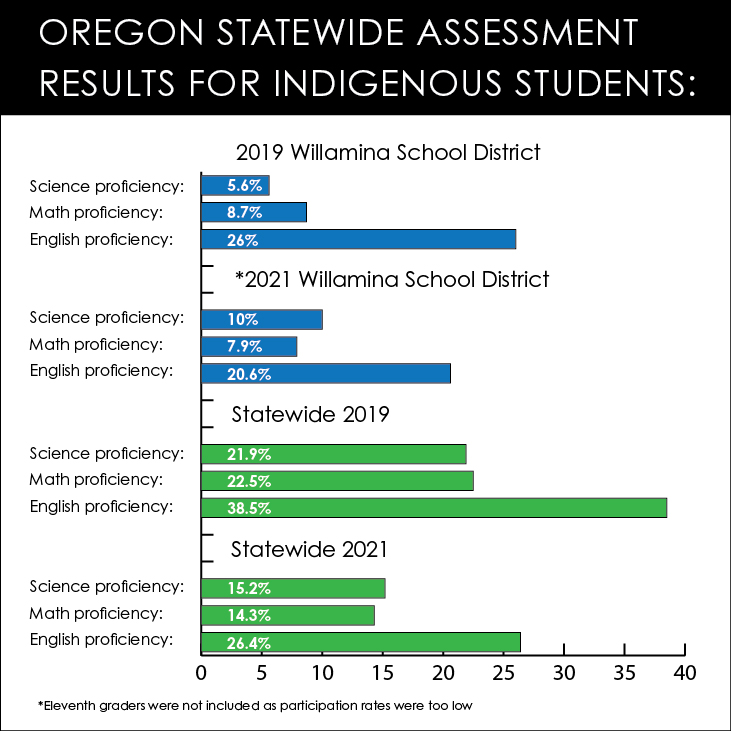Health & Education
Willamina Tribal students’ scores fall in English and math; improve in science

By Danielle Harrison
Smoke Signals assistant editor/staff writer
WILLAMINA -- Like their contemporaries around the state, local Tribal students in the Willamina School District saw declines in both their math and English scores after two years of pandemic-related disruptions.
However, there were modest gains in science.
The Oregon Department of Education released its first post-pandemic statewide assessment results on Thursday, Sept. 22.
“I believe the losses we are seeing are similar to many districts, attendance, quarantine and lack of social activity each played a role in the lower scores,” Willamina School District Superintendent Carrie Zimbrick said. “In addition, many students in third and fifth grade have never taken a state assessment until last year. The test itself is a heavy lift.”
She added that the science test is easier for students because there is less emphasis on narrative answers and it also tests over standards from the previous years.
Although Willamina School District estimates are that approximately 40 percent of the students are Tribal, those who self-identify solely as American Indian/Alaska Native are low because many Tribal students identify as other races or multiracial, which also affects the test numbers because it is an incomplete picture, officials say.
The Willamina scores this year officially record the scores of American Indian/Alaska Native third- through eighth-graders. The number of 11th-graders participating in the tests was too low to count for comparison purposes, mirroring a trend at the state level.
It’s the first time in three years that the state has conducted assessments due to the COVID-19 pandemic, when most schools conducted their learning remotely for almost 18 months.
In Willamina, Tribal students decreased in math proficiency from 8.7 percent in 2019 to 7.9 percent in 2022. English Language Arts proficiency decreased from 26 percent to 20.6 percent, while science proficiency rose from 5.6 percent to 10 percent.
“We will put a lot of emphasis on attendance this year and creating a positive school culture, both welcoming and safe,” Zimbrick said. “Teachers will focus on big picture standards in the core subjects and provide a lot of individual support to students. Overall, our Native students did well compared to their peers, particularly in ninth grade on track and graduation rate.”
Statewide, students who identify as American Indian/Alaska Native saw overall proficiency scores drop from 22.5 percent to 14.3 percent in math, 35.8 percent to 26.4 percent in English and 21.9 percent to 15.2 percent in science.
The assessments are designed to identify differences in various student groups in third through eighth grade in the areas of English and math. Additionally, science tests are given to students in fifth, eighth and 11th grade. The term “proficient” refers to students’ achievement level and whether they are on track for college or a career after high school, according to a press release from the Oregon Department of Education.
“The assessment results are a call to action for Oregon to keep advancing the programs we know meet our students’ needs,” Department of Education Director Colt Gill said. “As expected, the pandemic had an impact on learning in Oregon and across the country.
“Thanks to lawmakers passing the Student Success Act, and the agency’s implementation of Elementary and Secondary School Emergency Relief funds, additional mental health and well-being supports, summer learning and other crucial programs providing engaging instruction and boosting mental health have been implemented. We believe the framework is in place to be able to help Oregon’s students achieve.
“Oregon’s students of color, Tribal citizens, students who experience disability, students navigating poverty and rural students were disproportionately impacted and investments to renew and accelerate learning need to focus on these communities. We stand with our districts as they move forward with the plans they created with local community input to address the needs they see in their schools.”
The state noted that 11th-grade scores shouldn’t be compared with previous year results or across schools and districts because the participation rates were below 60 percent. In Willamina, 67.4 of American Indian/Alaska Native students participated. Oregon allows parents to opt their students out of state testing. In the tests administered in 2019, almost 100 percent of the Willamina students participated.
“I am sad that our attendance rate was so low,” Zimbrick said. “We were on a great trajectory prior to COVID, improving in all key indicators for the past six years. We will get there and improve, it will just take time and effort.”
For more information on scores, visit oregon.gov/ode/educator-resources/assessment.
